Enhanced Antibacterial Activity of Silver Doped Titanium Dioxide-Chitosan Composites under Visible Light
Abstract
:1. Introduction
2. Materials and Methods
2.1. Materials
2.2. Surface Modification of Nano TiO2
2.3. Preparation of Ag Doped Titania-Chitosan (STC)
2.4. Characterization
2.5. Antimicrobial Assays
3. Results and Discussion
3.1. Structure and Morphology of STC Composites
3.2. Effect of Particle Size on Antibacterial Activity
3.3. Effect of Visible Light Photocatalysis on Antibacterial Activity
3.4. Possible Antibacterial Mechanism
4. Conclusions
5. Patents
Author Contributions
Funding
Conflicts of Interest
References
- Ruel-Gariépy, E.; Leroux, J.-C. Chitosan: A natural polycation with multiple applications. Polysacch. Drug Deliv. Pharm. Appl. 2006, 934, 243–259. [Google Scholar] [CrossRef]
- Wu, Y.; He, J.; Cheng, W.; Gu, H.; Guo, Z.; Gao, S.; Huang, Y. Oxidized regenerated cellulose-based hemostat with microscopically gradient structure. Carbohydr. Polym. 2012, 88, 1023–1032. [Google Scholar] [CrossRef]
- Munozbonilla, A.; Cerrada, M.; Fernandezgarcia, M. Polymeric materials with antimicrobial activity. Prog. Polym. Sci. 2012, 37, 281–339. [Google Scholar] [CrossRef]
- Guaresti, O.; Garcia-Astrain, C.; Palomares, T.; Alonso-Varona, A.; Eceiza, A.; Gabilondo, N. Synthesis and characterization of a biocompatible chitosan-based hydrogel cross-linked via ‘click’ chemistry for controlled drug release. Int. J. Biol. Macromol. 2017, 102, 1–9. [Google Scholar] [CrossRef] [PubMed]
- Tahtat, D.; Mahlous, M.; Benamer, S.; Khodja, A.N.; Oussedik-Oumehdi, H.; Laraba-Djebari, F. Oral delivery of insulin from alginate/chitosan crosslinked by glutaraldehyde. Int. J. Biol. Macromol. 2013, 58, 160–168. [Google Scholar] [CrossRef] [PubMed]
- Qin, H.; Li, J.; He, B.; Sun, J.; Li, L.; Qian, L. Novel wearable electrodes based on conductive chitosan fabrics and their application in smart garments. Materials 2018, 11, 370. [Google Scholar] [CrossRef] [PubMed]
- Yang, X.L.; Ju, X.J.; Mu, X.T.; Wang, W.; Xie, R.; Liu, Z.; Chu, L.Y. Core-shell chitosan microcapsules for programmed sequential drug release. ACS Appl. Mater. Interfaces 2016, 8, 10524–10534. [Google Scholar] [CrossRef] [PubMed]
- Kim, D.H.; Nikles, D.E.; Brazel, C.S. Synthesis and characterization of multifunctional chitosan-MnFe2O4 nanoparticles for magnetic hyperthermia and drug delivery. Materials 2010, 3, 4051–4065. [Google Scholar] [CrossRef] [PubMed]
- Qian, B.; Song, Z.; Hao, L.; Wang, W.; Kong, D. Self-healing epoxy coatings based on nanocontainers for corrosion protection of mild steel. J. Electrochem. Soc. 2017, 164, C54–C60. [Google Scholar] [CrossRef]
- Lin, W.T.; Zhang, Y.Y.; Tan, H.L.; Ao, H.Y.; Duan, Z.L.; He, G.; Tang, T.T. Inhibited bacterial adhesion and biofilm formation on quaternized chitosan-loaded titania nanotubes with various diameters. Materials 2016, 9, 155. [Google Scholar] [CrossRef] [PubMed]
- Dou, Y.; Liu, H.; Peng, J.; Li, M.; Li, W.; Yang, F. A green method for preparation of CNT/CS/AGNP composites and evaluation of their catalytic performance. J. Mater. Sci. 2016, 51, 5685–5694. [Google Scholar] [CrossRef]
- Kang, Y.O.; Jung, J.Y.; Cho, D.; Kwon, O.H.; Cheon, J.Y.; Park, W.H. Antimicrobial silver chloride nanoparticles stabilized with chitosan oligomer for the healing of burns. Materials 2016, 9, 215. [Google Scholar] [CrossRef] [PubMed]
- Yang, C.H.; Wang, L.S.; Chen, S.Y.; Huang, M.C.; Li, Y.H.; Lin, Y.C.; Chen, P.F.; Shaw, J.F.; Huang, K.S. Microfluidic assisted synthesis of silver nanoparticle-chitosan composite microparticles for antibacterial applications. Int. J. Pharm. 2016, 510, 493–500. [Google Scholar] [CrossRef] [PubMed]
- Zhang, X.; Xiao, G.; Wang, Y.; Zhao, Y.; Su, H.; Tan, T. Preparation of chitosan-tio2 composite film with efficient antimicrobial activities under visible light for food packaging applications. Carbohydr. Polym. 2017, 169, 101–107. [Google Scholar] [CrossRef] [PubMed]
- Yoon, H.; Joshi, B.; Na, S.H.; Yoon, S.S. Antibacterial activity and photocatalysis of electrosprayed titania films. J. Electrochem. Soc. 2012, 159, H823–H827. [Google Scholar] [CrossRef]
- Liu, N.; Chang, Y.; Feng, Y.; Cheng, Y.; Sun, X.; Jian, H.; Feng, Y.; Li, X.; Zhang, H. {101}–{001} surface heterojunction-enhanced antibacterial activity of titanium dioxide nanocrystals under sunlight irradiation. ACS Appl. Mater. Interfaces 2017, 9, 5907–5915. [Google Scholar] [CrossRef] [PubMed]
- Zhang, Z.L.; Wan, M.; Mao, Y.L. Enhanced photovoltaic effect of TiO2-based composite ZnFE2O4/TiO2. J. Photochem. Photobiol. A Chem. 2012, 233, 15–19. [Google Scholar] [CrossRef]
- Chappanda, K.N.; Smith, Y.R.; Rieth, L.W.; Tathireddy, P.; Misra, M.; Mohanty, S.K. TiO2-WO3 composite nanotubes from co-sputtered thin films on Si substrate for enhanced photoelectrochemical water splitting. J. Electrochem. Soc. 2014, 161, H431–H437. [Google Scholar] [CrossRef]
- Jayamohan, H.; Smith, Y.R.; Gale, B.K.; Mohanty, K.S.; Misra, M. Photocatalytic microfluidic reactors utilizing titania nanotubes on titanium mesh for degradation of organic and biological contaminants. J. Environ. Chem. Eng. 2016, 4, 657–663. [Google Scholar] [CrossRef]
- Viet, V.P.; Phan, T.B.; Mott, D.; Maenosono, S.; Sang, T.T.; Thi, M.C.; Hieu, V.L. Silver nanoparticle loaded TiO2 nanotubes with high photocatalytic and antibacterial activity synthesized by photoreduction method. J. Photochem. Photobiol. A Chem. 2018, 352, 106–112. [Google Scholar] [CrossRef]
- Karthikeyan, K.T.; Nithya, A.; Jothivenkatachalam, K. Photocatalytic and antimicrobial activities of chitosan-TiO2 nanocomposite. Int. J. Biol. Macromol. 2017, 104, 1762–1773. [Google Scholar] [CrossRef] [PubMed]
- Zhao, W.F.; Duan, J.L.; Ji, B.; Ma, L.Z.; Yang, Z. Novel formation of large area N-TiO2/graphene layered materials and enhanced photocatalytic degradation of antibiotics. J. Environ. Chem. Eng. 2018. [Google Scholar] [CrossRef]
- Seery, M.K.; George, R.; Floris, P.; Pillai, S.C. Silver doped titanium dioxide nanomaterials for enhanced visible light photocatalysis. J. Photochem. Photobiol. A Chem. 2007, 189, 258–263. [Google Scholar] [CrossRef] [Green Version]
- Chambers, C.; Stewart, S.B.; Su, B.; Jenkinson, H.F.; Sandy, J.R.; Ireland, A.J. Silver doped titanium dioxide nanoparticles as antimicrobial additives to dental polymers. Dent Mater. 2017, 33, e115–e123. [Google Scholar] [CrossRef] [PubMed] [Green Version]
- Kovacs, G.; Pap, Z.; Cotet, C.; Cosoveanu, V.; Baia, L.; Danciu, V. Photocatalytic, morphological and structural properties of the TiO(2)-SiO(2)-ag porous structures based system. Materials 2015, 8, 1059–1073. [Google Scholar] [CrossRef] [PubMed]
- Xu, Z.; Li, M.; Li, X.; Liu, X.; Ma, F.; Wu, S.; Yeung, K.W.K.; Han, Y.; Chu, P.K. Antibacterial activity of silver doped titanate nanowires on Ti implants. ACS Appl. Mater. Interfaces 2016, 8, 16584–16594. [Google Scholar] [CrossRef] [PubMed]
- Dzimitrowicz, A.; Motyka, A.; Jamroz, P.; Lojkowska, E.; Babinska, W.; Terefinko, D.; Pohl, P.; Sledz, W. Application of silver nanostructures synthesized by cold atmospheric pressure plasma for inactivation of bacterial phytopathogens from the genera dickeya and pectobacterium. Materials 2018, 11, 331. [Google Scholar] [CrossRef] [PubMed]
- Chen, E.; Su, H.; Tan, T. Antimicrobial properties of silver nanoparticles synthesized by bioaffinity adsorption coupled with TiO2 photocatalysis. J. Chem. Technol. Biotechnol. 2011, 86, 421–427. [Google Scholar] [CrossRef]
- Wang, Y.; Duo, F.; Peng, S.; Jia, F.; Fan, C. Potassium iodate assisted synthesis of titanium dioxide nanoparticles with superior water-dispersibility. J. Colloid Interface Sci. 2014, 430, 31–39. [Google Scholar] [CrossRef] [PubMed]
- Schiffman, J.D.; Schauer, C.L. Cross-linking chitosan nanofibers. Biomacromolecules 2007, 8, 594–601. [Google Scholar] [CrossRef] [PubMed]
- Chen, C.; Lee, S.H.; Cho, M.; Kim, J.; Lee, Y. Cross-linked chitosan as an efficient binder for Si anode of li-ion batteries. ACS Appl. Mater. Interfaces 2016, 8, 2658–2665. [Google Scholar] [CrossRef] [PubMed]
- Kumar, S.; Deepak, V.; Kumari, M.; Dutta, P.K. Antibacterial activity of diisocyanate-modified chitosan for biomedical applications. Int. J. Biol. Macromol. 2016, 84, 349–353. [Google Scholar] [CrossRef] [PubMed]
- Singh, A.N.; Singh, S.; Suthar, N.; Dubey, V.K. Glutaraldehyde-activated chitosan matrix for immobilization of a novel cysteine protease, procerain b. J. Agric. Food Chem. 2011, 59, 6256–6262. [Google Scholar] [CrossRef] [PubMed]
- Hakouk, K.; Deniard, P.; Lajaunie, L.; Guillot-Deudon, C.; Harel, S.; Wang, Z.; Huang, B.; Koo, H.-J.; Whangbo, M.-H.; Jobic, S.; et al. Novel soft-chemistry route of Ag2Mo3O10·2H2O nanowires and in situ photogeneration of a Ag@AG2Mo3O10·2H2O plasmonic heterostructure. Inorg. Chem. 2013, 52, 6440–6449. [Google Scholar] [CrossRef] [PubMed]
- Ferraria, A.M.; Carapeto, A.P.; Botelho do Rego, A.M. X-ray photoelectron spectroscopy: Silver salts revisited. Vacuum 2012, 86, 1988–1991. [Google Scholar] [CrossRef]
- Leshuk, T.; Parviz, R.; Everett, P.; Krishnakumar, H.; Varin, R.A.; Gu, F. Photocatalytic activity of hydrogenated tio2. ACS Appl. Mater. Interfaces 2013, 5, 1892–1895. [Google Scholar] [CrossRef] [PubMed]
- Jing, Y.; Wang, H.; Chen, X.; Wang, X.; Wei, H.; Guo, Z. Pulsed laser deposited Ag nanoparticles on nickel hydroxide nanosheet arrays for highly sensitive surface-enhanced Raman scattering spectroscopy. Appl. Surface Sci. 2014, 316, 66–71. [Google Scholar] [CrossRef]
- Xiu, Z.M.; Zhang, Q.B.; Puppala, H.L.; Colvin, V.L.; Alvarez, P.J. Negligible particle-specific antibacterial activity of silver nanoparticles. Nano Lett. 2012, 12, 4271–4275. [Google Scholar] [CrossRef] [PubMed]
- Sahariah, P.; Benediktssdottir, B.E.; Hjalmarsdottir, M.A.; Sigurjonsson, O.E.; Sorensen, K.K.; Thygesen, M.B.; Jensen, K.J.; Masson, M. Impact of chain length on antibacterial activity and hemocompatibility of quaternary n-alkyl and n,n-dialkyl chitosan derivatives. Biomacromolecules 2015, 16, 1449–1460. [Google Scholar] [CrossRef] [PubMed]
- Liu, J.; Hurt, R.H. Ion release kinetics and particle persistence in aqueous nano-silver colloids. Environ. Sci. Technol. 2010, 44, 2169–2175. [Google Scholar] [CrossRef] [PubMed]
- Cui, L.; Chen, P.; Chen, S.; Yuan, Z.; Yu, C.; Ren, B.; Zhang, K. In situ study of the antibacterial activity and mechanism of action of silver nanoparticles by surface-enhanced Raman spectroscopy. Anal. Chem. 2013, 85, 5436–5443. [Google Scholar] [CrossRef] [PubMed]
- Wu, T.S.; Wang, K.X.; Li, G.D.; Sun, S.Y.; Sun, J.; Chen, J.S. Montmorillonite-supported Ag/TiO2 nanoparticles: An efficient visible-light bacteria photodegradation material. ACS Appl. Mater. Interfaces 2010, 2, 544–550. [Google Scholar] [CrossRef] [PubMed]
- Reddy, K.M.; Manorama, S.V.; Reddy, A.R. Bandgap studies on anatase titanium dioxide nanoparticles. Mater. Chem. Phys. 2002, 78, 239–245. [Google Scholar] [CrossRef]
- Stengl, V.; Houskova, V.; Bakardjieva, S.; Murafa, N. Photocatalytic activity of boron-modified titania under UV and visible-light illumination. ACS Appl. Mater. Interfaces 2010, 2, 575–580. [Google Scholar] [CrossRef] [PubMed]
- Yawalkar, A.A.; Bhatkhande, D.S.; Pangarkar, V.G. Solar-assisted photochemical and photocatalytic degradation of phenol. J. Chem. Technol. Biotechnol. 2001, 76, 363–370. [Google Scholar] [CrossRef]
- Qu, Z.; Liu, P.; Yang, X.; Wang, F.; Zhang, W.; Fei, C. Microstructure and characteristic of BiVO4 prepared under different pH values: Photocatalytic efficiency and antibacterial activity. Materials 2016, 9, 129. [Google Scholar] [CrossRef] [PubMed]
- Kiwi, J.; Nadtochenko, V. Evidence for the mechanism of photocatalytic degradation of the bacterial wall membrane at the TiO2 interface by atr-ftir and laser kinetic spectroscopy. Langmuir 2005, 21, 4631–4641. [Google Scholar] [CrossRef] [PubMed]
- Schneider, J.; Matsuoka, M.; Takeuchi, M.; Zhang, J.; Yu, H.; Anpo, M.; Bahnemann, D.W. Understanding TiO2 photocatalysis: Mechanisms and materials. Chem. Rev. 2014, 114, 9919–9986. [Google Scholar] [CrossRef] [PubMed]
- Sung-Suh, H.M.; Choi, J.R.; Hah, H.J.; Koo, S.M.; Bae, Y.C. Comparison of Ag deposition effects on the photocatalytic activity of nanoparticulate TiO2 under visible and UV light irradiation. J. Photochem. Photobiol. A Chem. 2004, 163, 37–44. [Google Scholar] [CrossRef]
- Puga, A.V. Photocatalytic production of hydrogen from biomass-derived feedstocks. Coord. Chem. Rev. 2016, 315, 1–66. [Google Scholar] [CrossRef]
- Malato, S.; Maldonado, M.I.; Fernández-Ibáñez, P.; Oller, I.; Polo, I.; Sánchez-Moreno, R. Decontamination and disinfection of water by solar photocatalysis: The pilot plants of the Plataforma Solar de Almeria. Mater. Sci. Semicond. Process. 2016, 42, 15–23. [Google Scholar] [CrossRef]
- Hou, X.; Huang, M.; Wu, X.; Liu, A. Preparation and studies of photocatalytic silver-loaded TiO2 films by hybrid sol–gel method. Chem. Eng. J. 2009, 146, 42–48. [Google Scholar] [CrossRef]
- Jose, S.; Fangueiro, J.F.; Smitha, J.; Cinu, T.A.; Chacko, A.J.; Premaletha, K.; Souto, E.B. Cross-linked chitosan microspheres for oral delivery of insulin: Taguchi design and in vivo testing. Colloids Surf. B 2012, 92, 175–179. [Google Scholar] [CrossRef] [PubMed]
- Von Gunten, U. Ozonation of drinking water: Part II. Disinfection and by-product formation in presence of bromide, iodide or chlorine. Water Res. 2003, 37, 1469–1487. [Google Scholar] [CrossRef]
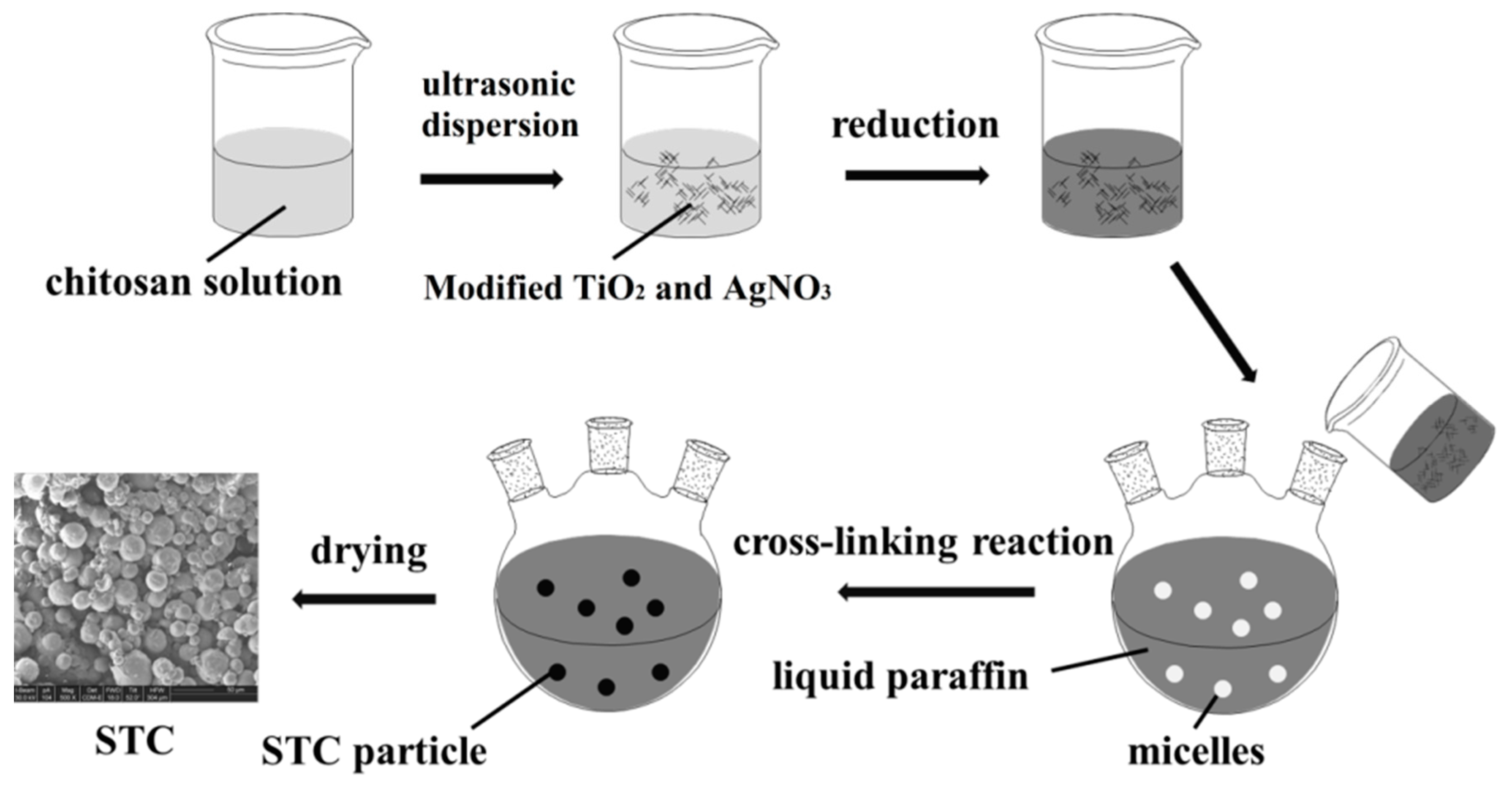
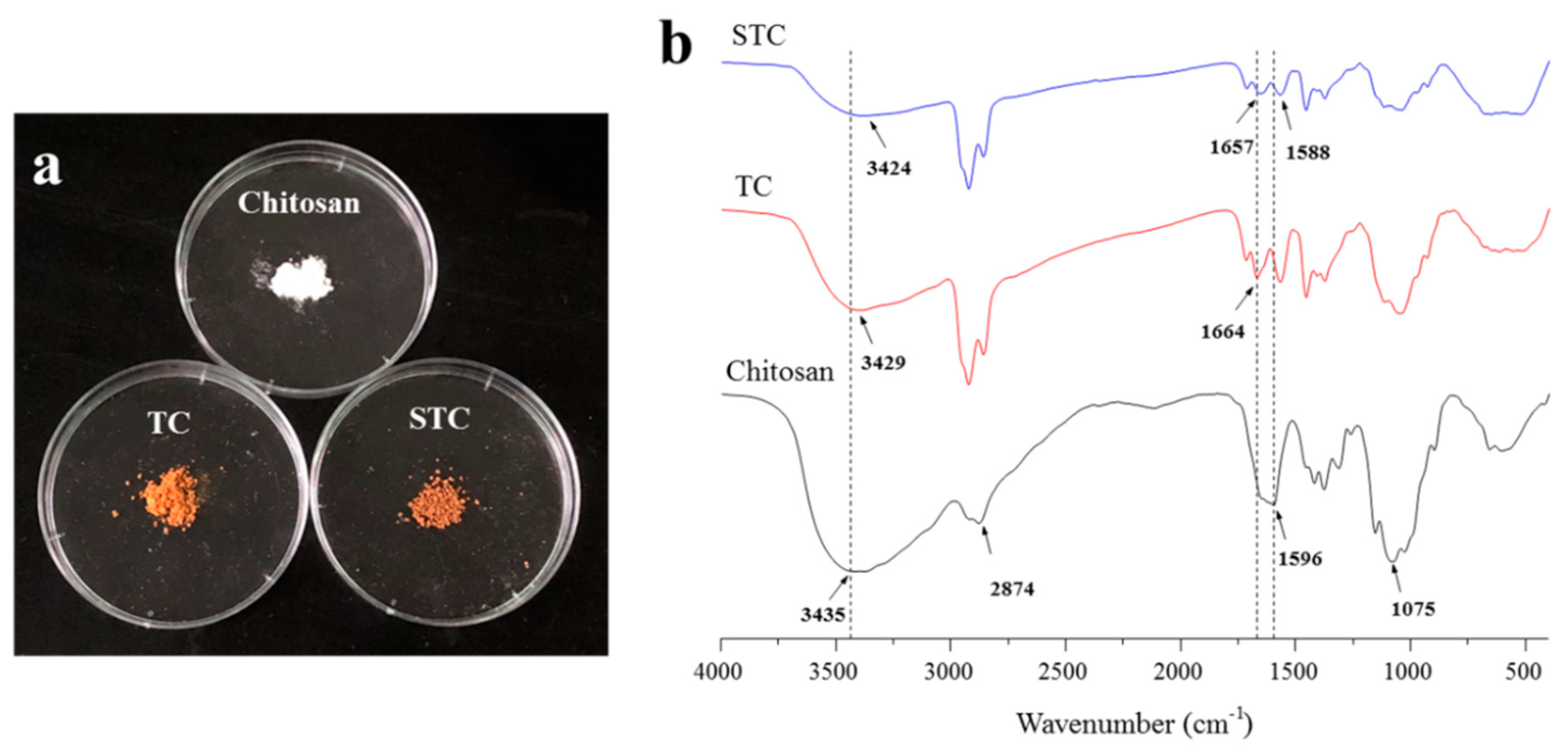


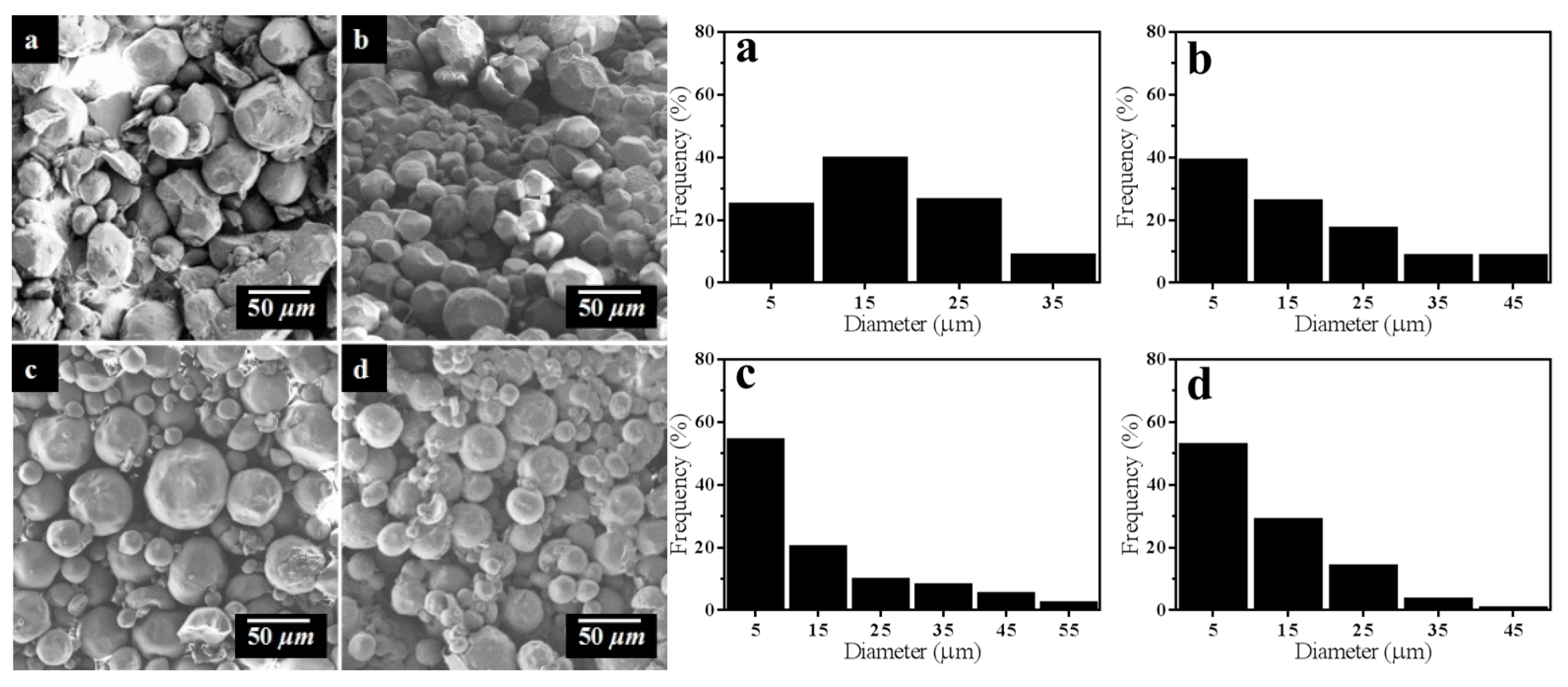
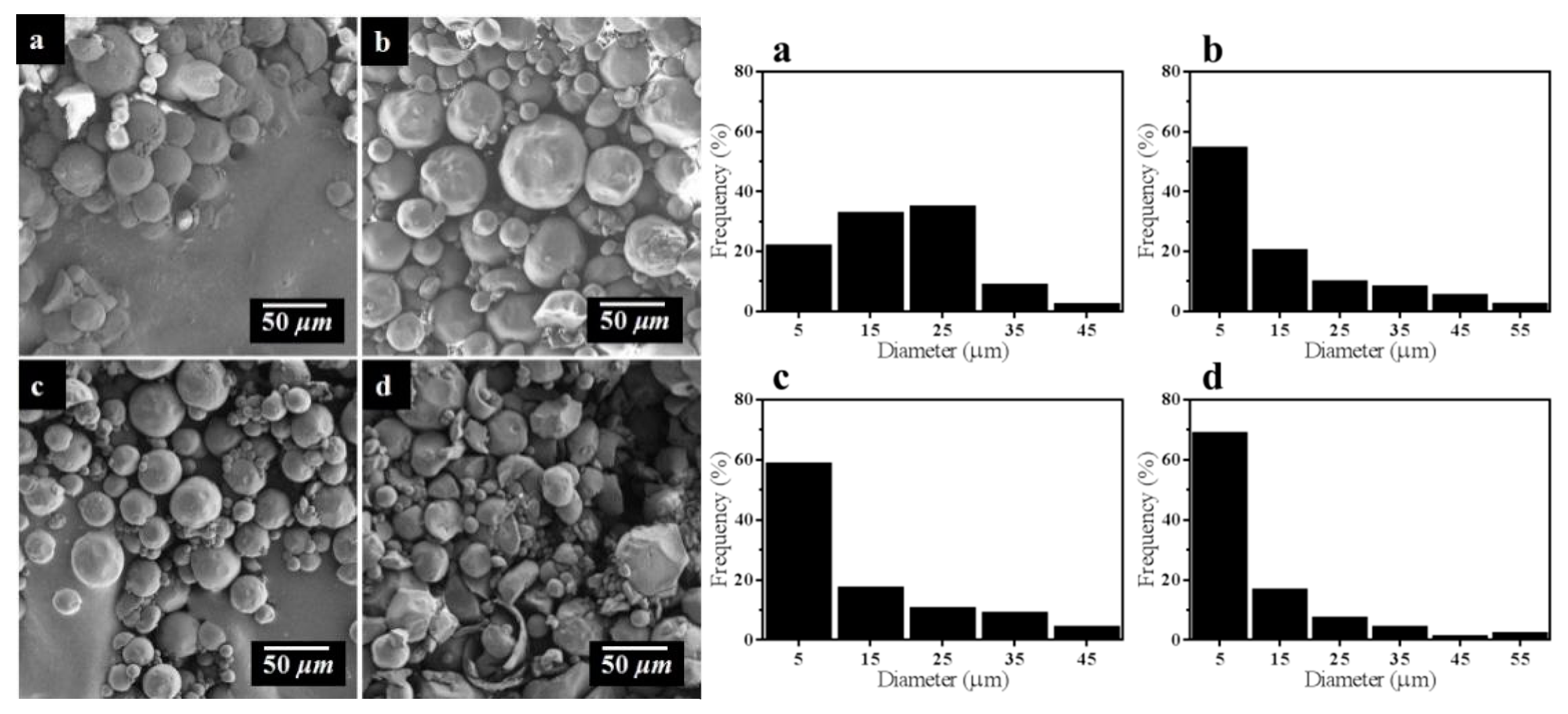
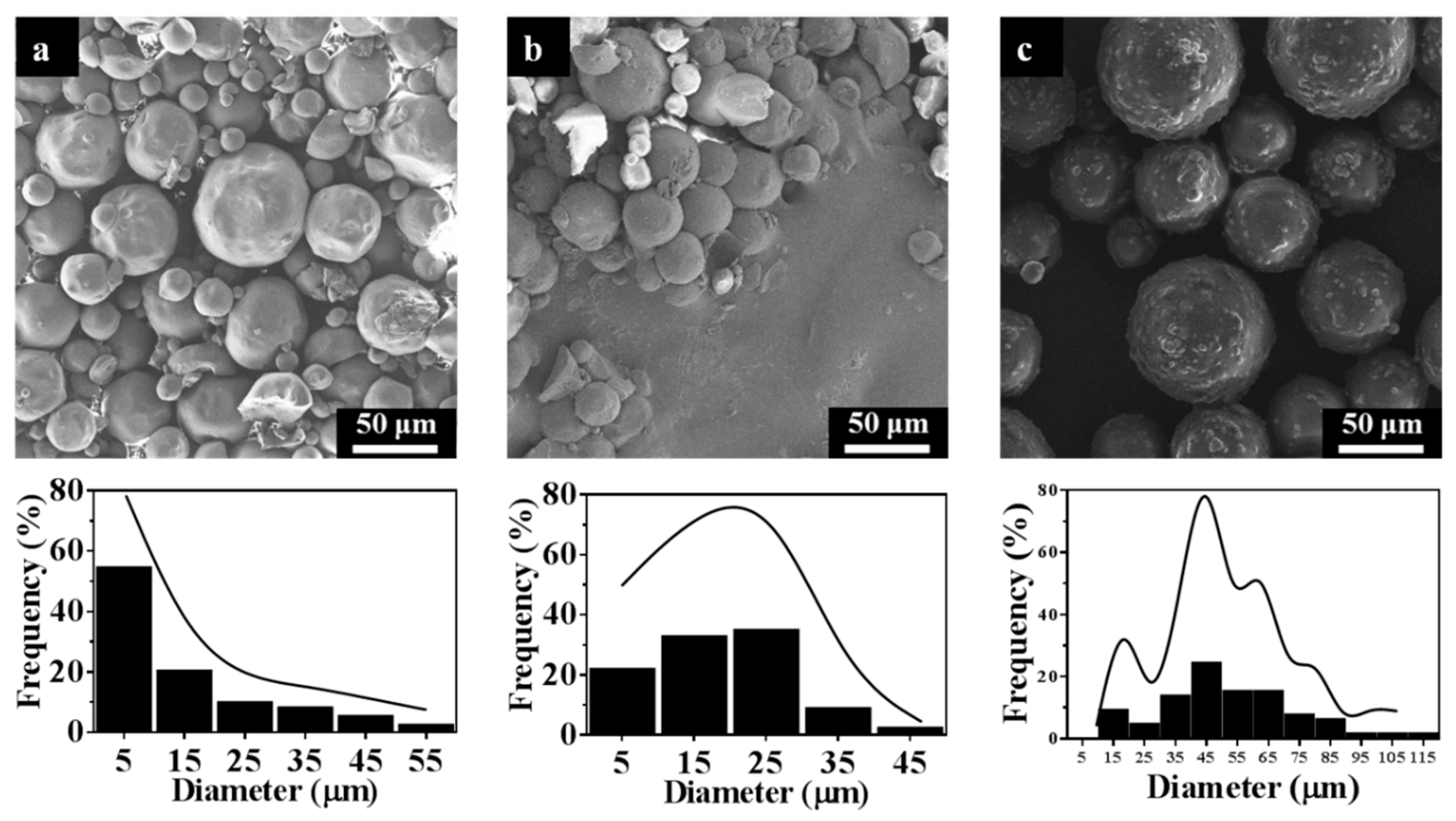
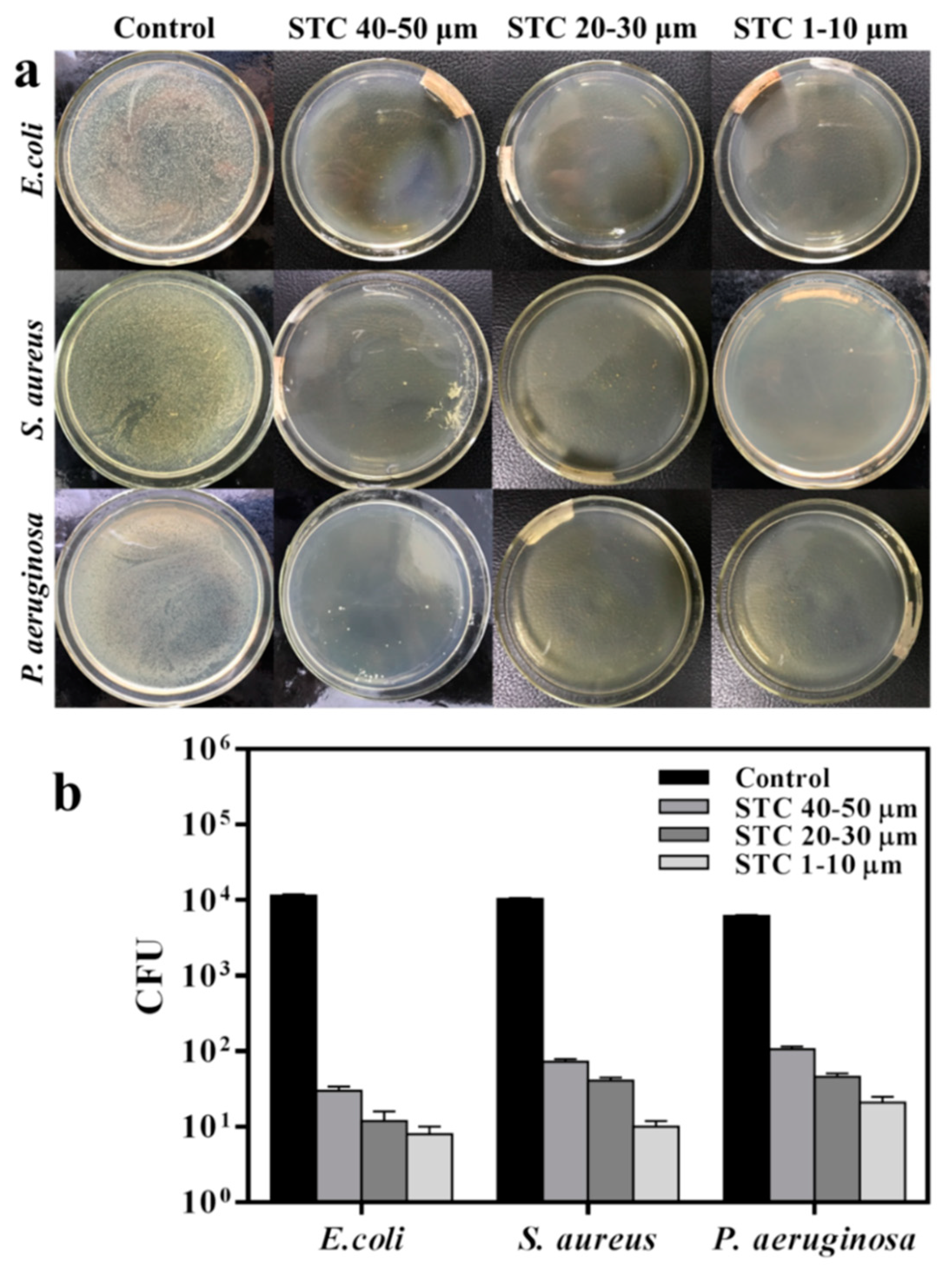
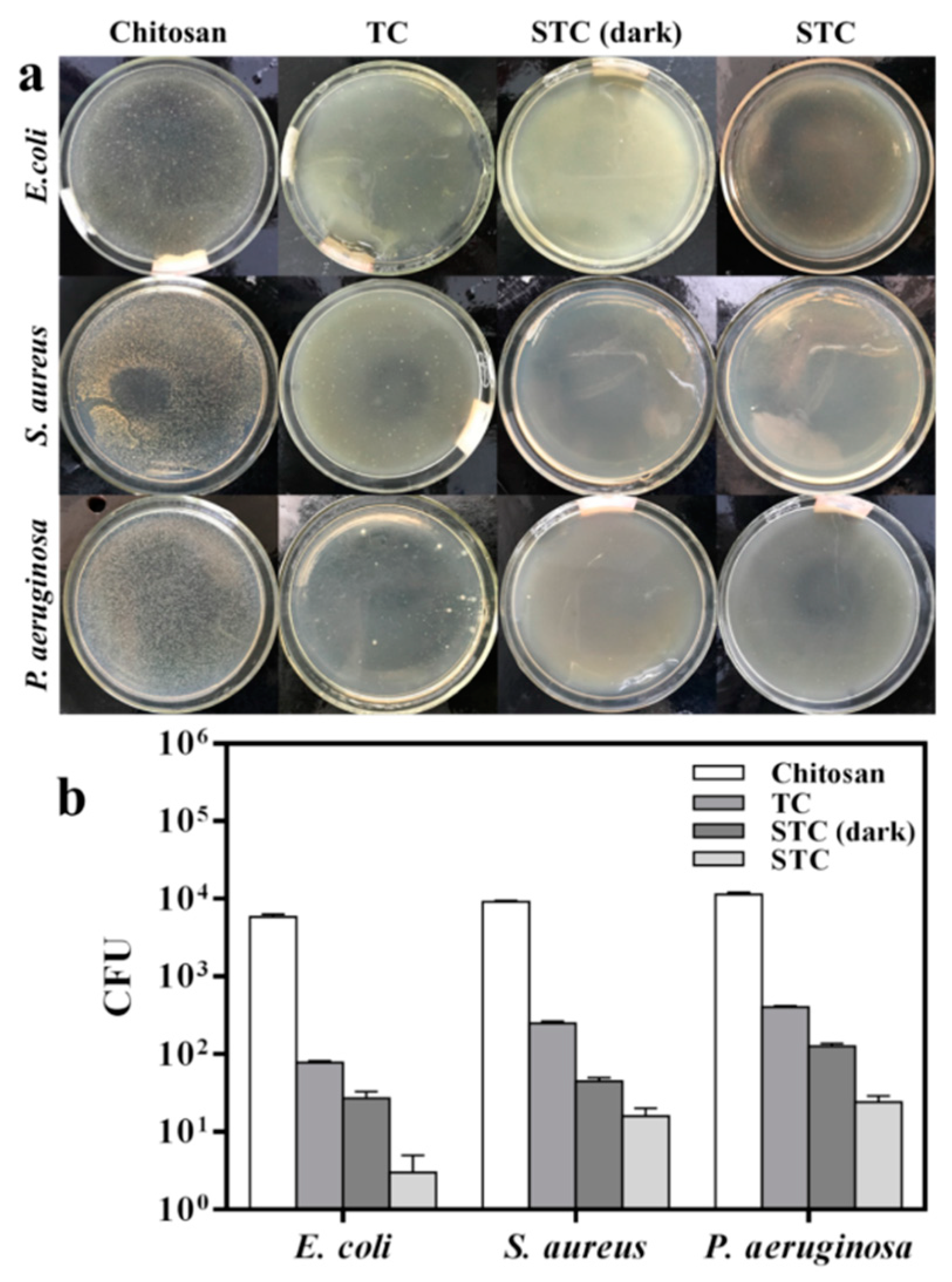
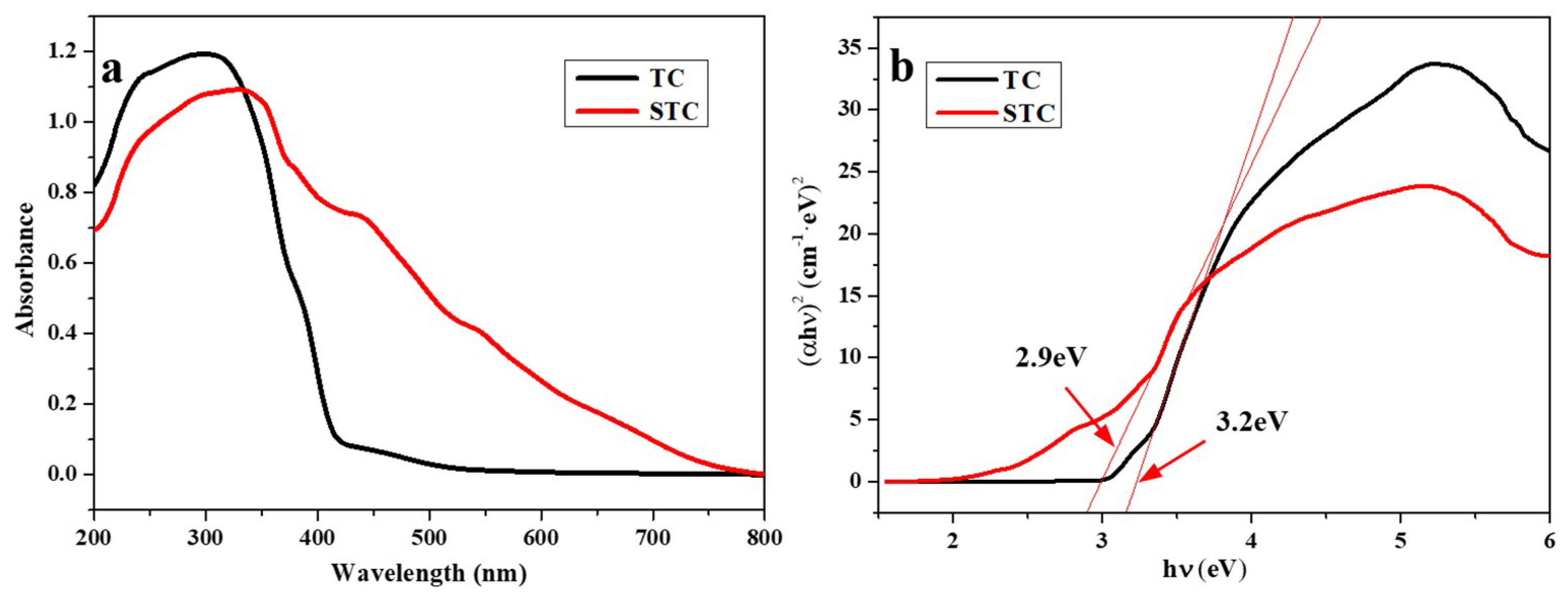
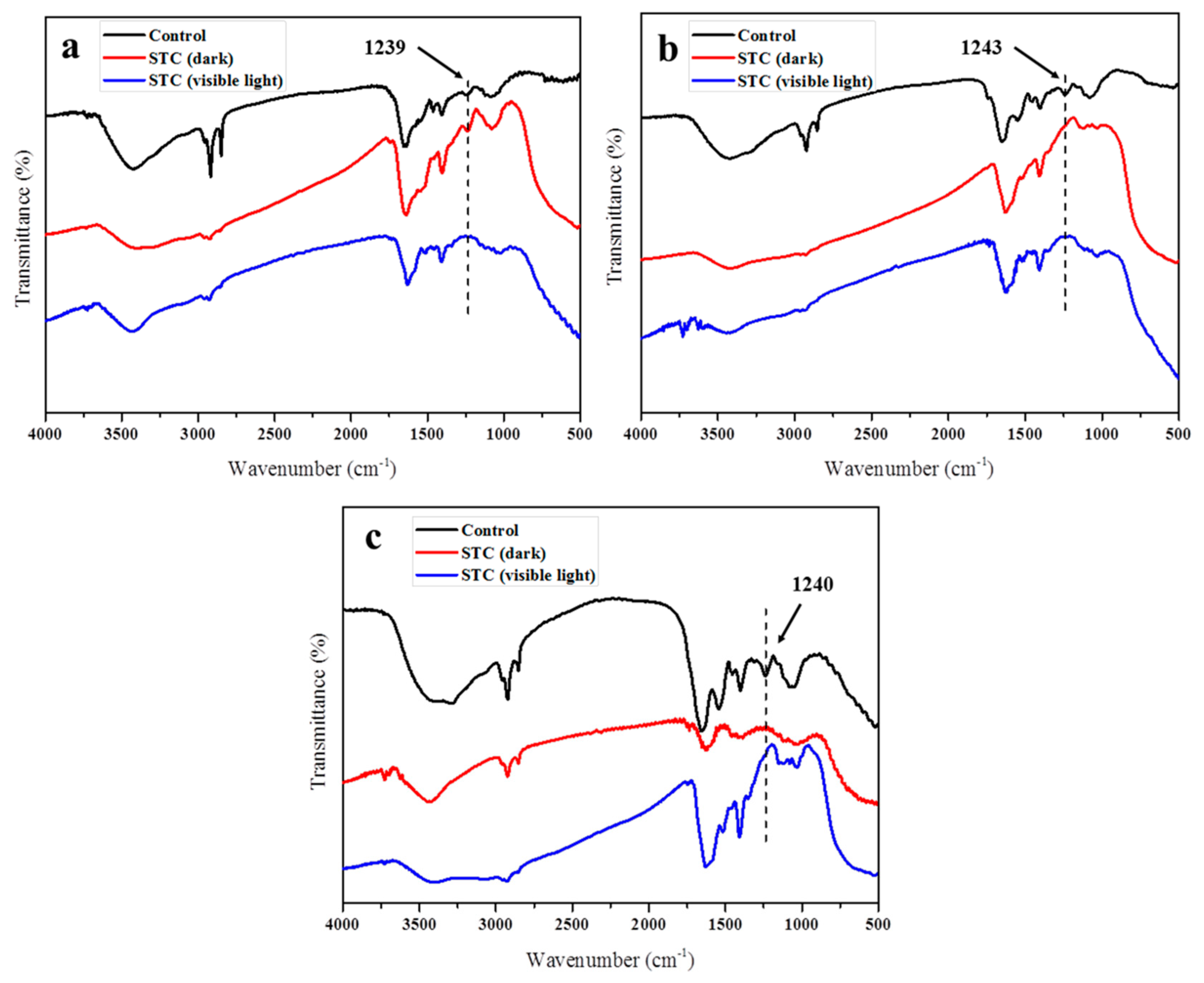
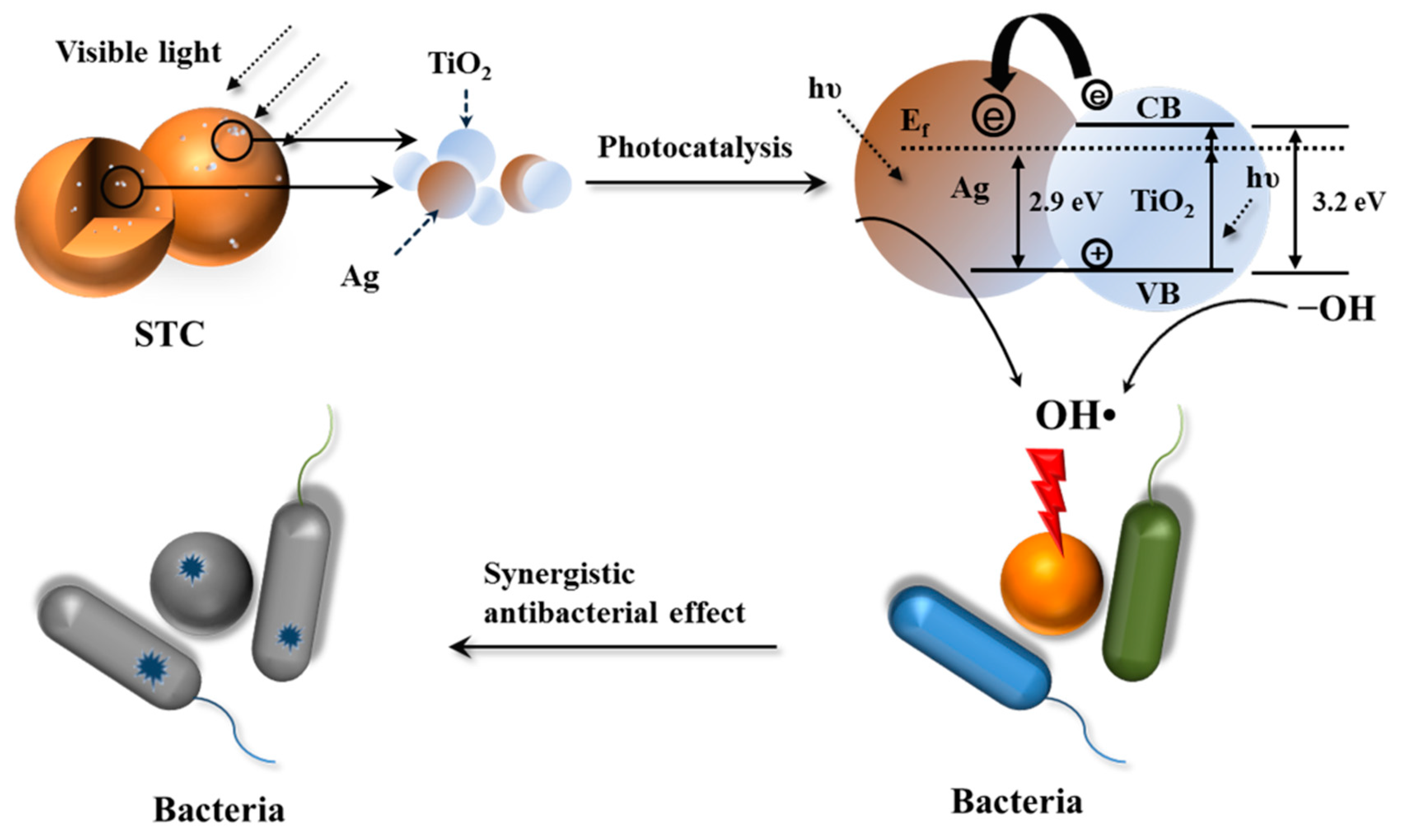
| No. | Reaction Parameters | Frequency of STC (1–10 μm) (%) | Frequency of STC (10–20 μm) (%) | Frequency of STC (20–30 μm) (%) | Frequency of STC (30–40 μm) (%) | Frequency of STC (40–50 μm) (%) | ||
|---|---|---|---|---|---|---|---|---|
| Dosage of Glutaraldehyde (% v/v) | Reaction Time (h) | Stirring Rate (r/min) | ||||||
| 1 | 1.0 | 4 | 450 | 25.00 | 39.70 | 26.48 | 8.82 | 0 |
| 2 | 1.5 | 4 | 450 | 39.13 | 26.09 | 17.39 | 8.70 | 8.70 |
| 3 | 2.0 | 4 | 450 | 54.34 | 20.23 | 9.83 | 8.09 | 5.20 |
| 4 | 2.5 | 4 | 450 | 52.82 | 28.87 | 14.09 | 3.52 | 0.70 |
| 5 | 2.0 | 2 | 450 | 21.74 | 32.61 | 34.78 | 8.70 | 2.17 |
| 6 | 2.0 | 6 | 450 | 58.64 | 17.28 | 10.47 | 8.90 | 4.19 |
| 7 | 2.0 | 8 | 450 | 68.75 | 16.67 | 7.29 | 4.17 | 1.04 |
| 8 | 2.0 | 4 | 300 | 0 | 9.09 | 4.55 | 13.64 | 24.24 |
| Bacteria | Control | STC 40–50 μm | STC 20–30 μm | STC 1–10 μm |
|---|---|---|---|---|
| CFU | CFU * (AR/%) | CFU * (AR/%) | CFU * (AR/%) | |
| E. coli | 1 × 104 | 30 (99.70) | 12 (99.88) | 8 (99.92) |
| S. aureus | 1 × 104 | 73 (99.27) | 41 (99.59) | 10 (99.90) |
| P. aeruginosa | 1 × 104 | 107 (98.93) | 46 (99.54) | 21 (99.79) |
| Bacteria | Control | Chitosan | TC | STC (Dark) * | STC |
|---|---|---|---|---|---|
| CFU | CFU ** (AR/%) | CFU ** (AR/%) | CFU ** (AR/%) | CFU ** (AR/%) | |
| E. coli | 1 × 104 | 5888 (41.12) | 78 (99.22) | 27 (99.73) | 3 (99.97) |
| S. aureus | 1 × 104 | 9216 (7.84) | 250 (97.50) | 45 (99.55) | 16 (99.84) |
| P. aeruginosa | 1 × 104 | 11456 (-) | 406 (95.94) | 127 (98.73) | 24 (99.76) |
© 2018 by the authors. Licensee MDPI, Basel, Switzerland. This article is an open access article distributed under the terms and conditions of the Creative Commons Attribution (CC BY) license (http://creativecommons.org/licenses/by/4.0/).
Share and Cite
Li, J.; Xie, B.; Xia, K.; Li, Y.; Han, J.; Zhao, C. Enhanced Antibacterial Activity of Silver Doped Titanium Dioxide-Chitosan Composites under Visible Light. Materials 2018, 11, 1403. https://doi.org/10.3390/ma11081403
Li J, Xie B, Xia K, Li Y, Han J, Zhao C. Enhanced Antibacterial Activity of Silver Doped Titanium Dioxide-Chitosan Composites under Visible Light. Materials. 2018; 11(8):1403. https://doi.org/10.3390/ma11081403
Chicago/Turabian StyleLi, Jie, Bing Xie, Kai Xia, Yingchun Li, Jing Han, and Chunmao Zhao. 2018. "Enhanced Antibacterial Activity of Silver Doped Titanium Dioxide-Chitosan Composites under Visible Light" Materials 11, no. 8: 1403. https://doi.org/10.3390/ma11081403







